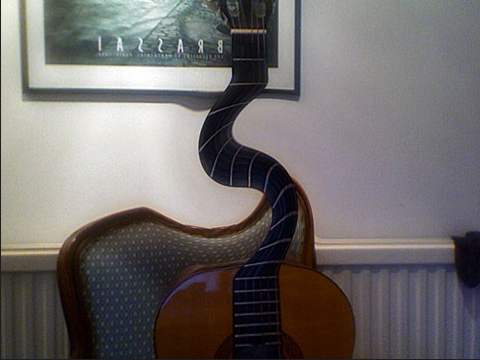Picasso’s guitar?

No, mine, viewed through a distorting lens.
Quote of the Day
”The McDaniel hiring speaks to a long-running poverty of imagination at television’s news divisions. Network bosses have come to believe that the news is a river that flows out of the mouths of official sources and is then routed to viewers by former members of the club.”
- Jack Shafer, commenting on NBC’s decision to hire Ronna McDaniel, the recently sacked Republican National Committee chair (and accomplished Trump accomplice) — to a paid gig in its studio.
Musical alternative to the morning’s radio news
Planxty | Live On Aisling Ghael Special | Scoil Lorcáin, Monkstown, Dublin, Nov 1979
Plenty was the greatest Irish folk group of my time. I first heard them in August 1972, when they had been going for about six months. It was in a small, hot crowded room in an hotel on the northern shore of Galway Bay, and I vividly remember being transfixed by them, and — mesmerised by the Uileann piper, Liam O’Flynn, who went on to become the greatest piper of his generation. It was one of those evenings one never forgets.
The video of this recording is pretty crude, and the audio quality poor. But what I liked about it is the way it accurately evokes the mood of that Summer evening in Connemara.
Long Read of the Day
Jonathan Haidt on ‘The Great Rewiring of childhood’.
Haidt is a prominent social psychologist on a mission: to persuade the (Western) world that the levels of mental illness we are currently seeing in teenagers are due mainly to two things — the over-protective parenting they have had, and the pathological impact of social media on them (especially girls). His latest book seems to place most of the blame on the latter.
I haven’t read the book (yet), but was intrigued by an interview David Epstein did with him. The transcript is long but well worth reading.
Sample:
DE: You make a point in the book that’s in my mind, because I just saw some clips from the recent Congressional hearings with social media executives, where they were discussing harm and sexual exploitation and harassment of teenage girls. And at one point Mark Zuckerberg is made to turn around and apologize to families who were there who say that their children were victimized or died for reasons linked to social media. And I don’t know how to parse all of that, but it did remind me of a recurring theme in your book: that we became obsessed about safety for kids outdoors — while by every measure outdoors was getting safer since the 1990s — and completely ignored safety in the virtual world. We ignored it so much that — as you write — by law, a 13-year-old can essentially sign a contract with a company to give away their data, and even the 13-year-old age limit has no meaningful enforcement.
JH: We’ve overprotected our children in the real world, and we’ve underprotected them online. And you laying it out that way just made me realize something: that the real world used to be quite dangerous. It used to be for the last, you know, 200 or 300 million years, that when your kids wandered off out of sight, there was a good chance they’d be eaten. So the real world has always been dangerous for young mammals, yet they evolved to play. Play is so important for brain development that even when the world was insanely dangerous, for hundreds of millions of years mammal babies still went out and played, often out of sight of their mothers. That’s how important it is to play. And then we get to civilization, and murder rates plummet. Predation rates drop to zero; there are no animals eating our kids. And the chance that they’ll be murdered is microscopic, in modern societies, so things get safer and safer. But when I was growing up in the ‘70s and ‘80s, there was a huge crime wave. There were a lot of weirdos, there were a lot of drunk drivers. So even in the ‘70s and ‘80s, it was much safer than previous times in history, but even still, there were risks. All those risks plummeted by the ‘90s. Drunk drivers were locked up and dissuaded; there’s much less drunk driving now. And, you know, my sister was flashed when she was a teenager — a guy just opened his raincoat. And that sort of thing happened a lot, because we didn’t lock those people away for 20 years, but now we do. So there are still people out there, but they have learned: don’t approach a kid, you’ll be arrested; just go on to Instagram — it’s safe. So as I say in the book, if we want to keep our kids safe, get them off of Instagram and send them out to play.
DE: This reminded me of the part of the book that discusses the decline in ER visits, particularly among boys, because they’re not outside engaging in risky play as much. So does this indicate that, in a way, we might want some more broken bones? Not for their own sake, of course, but as indicators that kids are outside taking some risks that might get them hurt, but not permanently, and are important for development…
In some ways Haidt reminds me of the late lamented Neil Postman, who was (IMO) the greatest cultural critic of his day. He too was a persuasive critic of the technology of his time, particularly broadcast TV, and he wrote a series of perceptive, readable and often very witty books about it, notably Amusing Ourselves to Death, The Disappearance of Childhood and Technopoly: The Surrender of Culture to Technology, all of which are sitting on my bookshelves as I write.
My commonplace booklet
Cultural Memory in the Digital
Thoughtful little essay by René Walter on the intrinsic hostility to cultural memory in a digital world.
As W. David Marx in No Canon for Old Memes correctly writes, “Memes are cheap, fast, and disposable. They lose their cultural value instantly (…) Memes should be understood as a medium for expression on contemporary matters. But what is said or celebrated at any moment is only meant for that moment.”
There is no mechanism for a longterm cultural memory in the digital, everything stays fluid and is edited by a giant swarm of humans in every moment. The digital turns cultural memory in a constant river of changing cultural expressions.
But a cultural memory by definition is fixed, it’s canonized knowledge, it expresses itself over time in crystalized shapes and in things that shall not be changed. Society memorizes its history in mythologies, expressed in the arts, in rituals, in literature, in architecture and monuments, in a shared practice of doing things. Comparable to the biological neural memory in the single human brain we collectively write our history into culture.
Feedback
Karel Tripp was moved by the strange photograph at the head of Monday’s edition to send me a remarkable photograph she had taken during the funeral of the late Queen.

“My picture”, she wrote,
“reminded me of the composite shot I took from the TV coverage of the Queen’s lying in state in Westminster. With a careful look you can see many aspects of the occasion all captured in one opportune moment with my iPhone 13 Pro. I am quietly proud of this even though it required absolutely no skill on my part.
That’s not quite right, IMO. Sure, the iPhone camera did the work. But it took a photographer’s ‘eye’ to see it.
This Blog is also available as an email three days a week. If you think that might suit you better, why not subscribe? One email on Mondays, Wednesdays and Fridays delivered to your inbox at 6am UK time. It’s free, and you can always unsubscribe if you conclude your inbox is full enough already!
